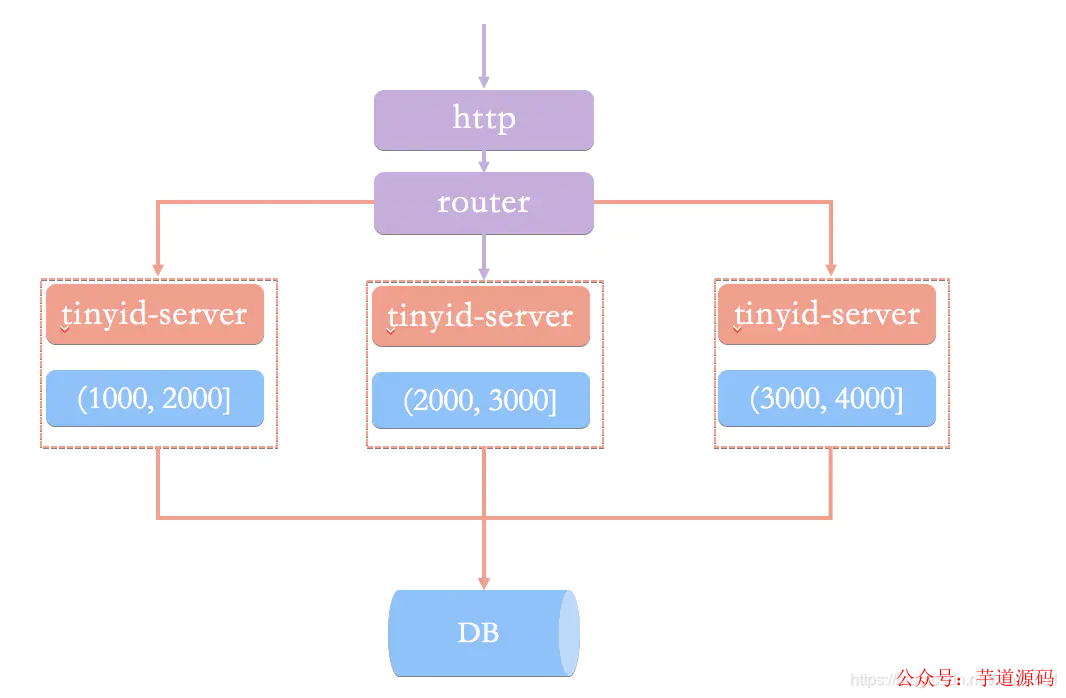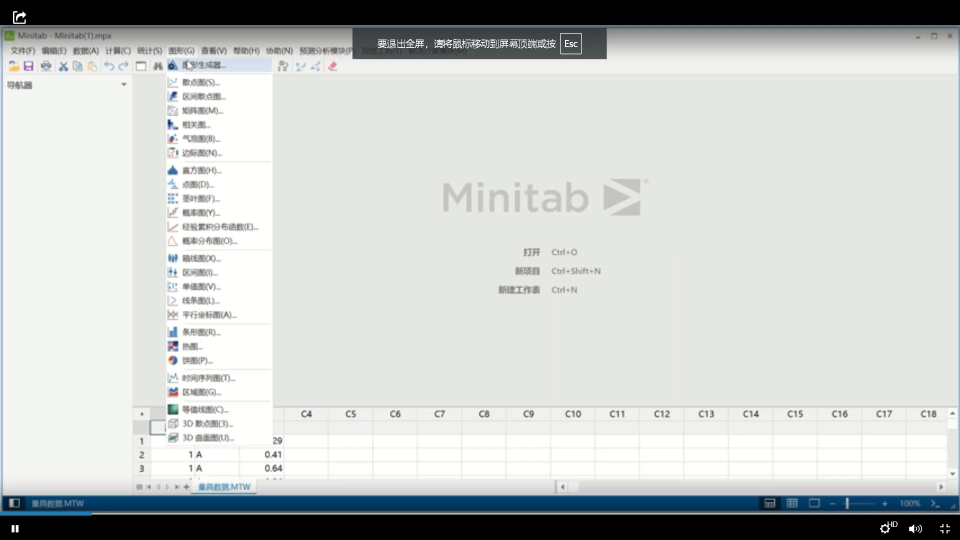Tinyid是滴滴開發(fā)的一款分布式ID系統(tǒng),Tinyid是在美團(Leaf)的leaf-segment算法基礎(chǔ)上升級而來,不僅支持了數(shù)據(jù)庫多主節(jié)點模式,還提供了tinyid-client客戶端的接入方式,使用起來更加方便。但和美團(Leaf)不同的是,Tinyid只支持號段一種模式不支持雪花模式。
Tinyid的特性
- 全局唯一的long型ID
- 趨勢遞增的id
- 提供 http 和 java-client 方式接入
- 支持批量獲取ID
- 支持生成1,3,5,7,9...序列的ID
- 支持多個db的配置
適用場景 :只關(guān)心ID是數(shù)字,趨勢遞增的系統(tǒng),可以容忍ID不連續(xù),可以容忍ID的浪費
不適用場景 :像類似于訂單ID的業(yè)務(wù),因生成的ID大部分是連續(xù)的,容易被掃庫、或者推算出訂單量等信息
基于 Spring Boot + MyBatis Plus + Vue & Element 實現(xiàn)的后臺管理系統(tǒng) + 用戶小程序,支持 RBAC 動態(tài)權(quán)限、多租戶、數(shù)據(jù)權(quán)限、工作流、三方登錄、支付、短信、商城等功能
- 項目地址:https://github.com/YunaiV/ruoyi-vue-pro
- 視頻教程:https://doc.iocoder.cn/video/
Tinyid原理
Tinyid是基于號段模式實現(xiàn),再簡單啰嗦一下號段模式的原理:就是從數(shù)據(jù)庫批量的獲取自增ID,每次從數(shù)據(jù)庫取出一個號段范圍,例如 (1,1000] 代表1000個ID,業(yè)務(wù)服務(wù)將號段在本地生成1~1000的自增ID并加載到內(nèi)存.。
Tinyid會將可用號段加載到內(nèi)存中,并在內(nèi)存中生成ID,可用號段在首次獲取ID時加載,如當(dāng)前號段使用達到一定比例時,系統(tǒng)會異步的去加載下一個可用號段,以此保證內(nèi)存中始終有可用號段,以便在發(fā)號服務(wù)宕機后一段時間內(nèi)還有可用ID。
原理圖大致如下圖:
 Tinyid原理圖
Tinyid原理圖基于 Spring Cloud Alibaba + Gateway + Nacos + RocketMQ + Vue & Element 實現(xiàn)的后臺管理系統(tǒng) + 用戶小程序,支持 RBAC 動態(tài)權(quán)限、多租戶、數(shù)據(jù)權(quán)限、工作流、三方登錄、支付、短信、商城等功能
Tinyid實現(xiàn)
Tinyid的GitHub地址 :https://github.com/didi/tinyid.git
Tinyid提供了兩種調(diào)用方式,一種基于Tinyid-server提供的http方式,另一種Tinyid-client客戶端方式。不管使用哪種方式調(diào)用,搭建Tinyid都必須提前建表tiny_id_info、tiny_id_token。
CREATETABLE`tiny_id_info`(
`id`bigint(20)unsignedNOTNULLAUTO_INCREMENTCOMMENT'自增主鍵',
`biz_type`varchar(63)NOTNULLDEFAULT''COMMENT'業(yè)務(wù)類型,唯一',
`begin_id`bigint(20)NOTNULLDEFAULT'0'COMMENT'開始id,僅記錄初始值,無其他含義。初始化時begin_id和max_id應(yīng)相同',
`max_id`bigint(20)NOTNULLDEFAULT'0'COMMENT'當(dāng)前最大id',
`step`int(11)DEFAULT'0'COMMENT'步長',
`delta`int(11)NOTNULLDEFAULT'1'COMMENT'每次id增量',
`remainder`int(11)NOTNULLDEFAULT'0'COMMENT'余數(shù)',
`create_time`timestampNOTNULLDEFAULT'2010-01-010000'COMMENT'創(chuàng)建時間',
`update_time`timestampNOTNULLDEFAULT'2010-01-010000'COMMENT'更新時間',
`version`bigint(20)NOTNULLDEFAULT'0'COMMENT'版本號',
PRIMARYKEY(`id`),
UNIQUEKEY`uniq_biz_type`(`biz_type`)
)ENGINE=InnoDBAUTO_INCREMENT=1DEFAULTCHARSET=utf8COMMENT'id信息表';
CREATETABLE`tiny_id_token`(
`id`int(11)unsignedNOTNULLAUTO_INCREMENTCOMMENT'自增id',
`token`varchar(255)NOTNULLDEFAULT''COMMENT'token',
`biz_type`varchar(63)NOTNULLDEFAULT''COMMENT'此token可訪問的業(yè)務(wù)類型標(biāo)識',
`remark`varchar(255)NOTNULLDEFAULT''COMMENT'備注',
`create_time`timestampNOTNULLDEFAULT'2010-01-010000'COMMENT'創(chuàng)建時間',
`update_time`timestampNOTNULLDEFAULT'2010-01-010000'COMMENT'更新時間',
PRIMARYKEY(`id`)
)ENGINE=InnoDBAUTO_INCREMENT=1DEFAULTCHARSET=utf8COMMENT'token信息表';
INSERTINTO`tiny_id_info`(`id`,`biz_type`,`begin_id`,`max_id`,`step`,`delta`,`remainder`,`create_time`,`update_time`,`version`)
VALUES
(1,'test',1,1,100000,1,0,'2018-07-212358','2018-07-222327',1);
INSERTINTO`tiny_id_info`(`id`,`biz_type`,`begin_id`,`max_id`,`step`,`delta`,`remainder`,`create_time`,`update_time`,`version`)
VALUES
(2,'test_odd',1,1,100000,2,1,'2018-07-212358','2018-07-230024',3);
INSERTINTO`tiny_id_token`(`id`,`token`,`biz_type`,`remark`,`create_time`,`update_time`)
VALUES
(1,'0f673adf80504e2eaa552f5d791b644c','test','1','2017-12-141646','2017-12-141648');
INSERTINTO`tiny_id_token`(`id`,`token`,`biz_type`,`remark`,`create_time`,`update_time`)
VALUES
(2,'0f673adf80504e2eaa552f5d791b644c','test_odd','1','2017-12-141646','2017-12-141648');
tiny_id_info表是具體業(yè)務(wù)方號段信息數(shù)據(jù)表

max_id :號段的最大值
step:步長,即為號段的長度
biz_type:業(yè)務(wù)類型
號段獲取對max_id字段做一次update操作,update max_id= max_id + step,更新成功則說明新號段獲取成功,新的號段范圍是(max_id ,max_id +step]。
tiny_id_token是一個權(quán)限表,表示當(dāng)前token可以操作哪些業(yè)務(wù)的號段信息。

修改tinyid-server中 offlineapplication.properties 文件配置數(shù)據(jù)庫,由于tinyid支持?jǐn)?shù)據(jù)庫多master模式,可以配置多個數(shù)據(jù)庫信息。啟動 TinyIdServerApplication 測試一下。
datasource.tinyid.primary.driver-class-name=com.mysql.jdbc.Driver
datasource.tinyid.primary.url=jdbc//127.0.0.1:3306/xin-master?autoReconnect=true&useUnicode=true&characterEncoding=UTF-8
datasource.tinyid.primary.username=junkang
datasource.tinyid.primary.password=junkang
datasource.tinyid.primary.testOnBorrow=false
datasource.tinyid.primary.maxActive=10
datasource.tinyid.secondary.driver-class-name=com.mysql.jdbc.Driver
datasource.tinyid.secondary.url=jdbc//localhost:3306/db2?autoReconnect=true&useUnicode=true&characterEncoding=UTF-8
datasource.tinyid.secondary.username=root
datasource.tinyid.secondary.password=123456
datasource.tinyid.secondary.testOnBorrow=false
datasource.tinyid.secondary.maxActive=10
1、Http方式
tinyid內(nèi)部一共提供了四個http接口來獲取ID和號段。
packagecom.xiaoju.uemc.tinyid.server.controller;
/**
*@authordu_imba
*/
@RestController
@RequestMapping("/id/")
publicclassIdContronller{
privatestaticfinalLoggerlogger=LoggerFactory.getLogger(IdContronller.class);
@Autowired
privateIdGeneratorFactoryServeridGeneratorFactoryServer;
@Autowired
privateSegmentIdServicesegmentIdService;
@Autowired
privateTinyIdTokenServicetinyIdTokenService;
@Value("${batch.size.max}")
privateIntegerbatchSizeMax;
@RequestMapping("nextId")
publicResponse>nextId(StringbizType,IntegerbatchSize,Stringtoken){
Response>response=newResponse<>();
try{
IdGeneratoridGenerator=idGeneratorFactoryServer.getIdGenerator(bizType);
Listids=idGenerator.nextId(newBatchSize);
response.setData(ids);
}catch(Exceptione){
response.setCode(ErrorCode.SYS_ERR.getCode());
response.setMessage(e.getMessage());
logger.error("nextIderror",e);
}
returnresponse;
}
@RequestMapping("nextIdSimple")
publicStringnextIdSimple(StringbizType,IntegerbatchSize,Stringtoken){
Stringresponse="";
try{
IdGeneratoridGenerator=idGeneratorFactoryServer.getIdGenerator(bizType);
if(newBatchSize==1){
Longid=idGenerator.nextId();
response=id+"";
}else{
ListidList=idGenerator.nextId(newBatchSize);
StringBuildersb=newStringBuilder();
for(Longid:idList){
sb.append(id).append(",");
}
response=sb.deleteCharAt(sb.length()-1).toString();
}
}catch(Exceptione){
logger.error("nextIdSimpleerror",e);
}
returnresponse;
}
@RequestMapping("nextSegmentId")
publicResponsenextSegmentId(StringbizType,Stringtoken) {
try{
SegmentIdsegmentId=segmentIdService.getNextSegmentId(bizType);
response.setData(segmentId);
}catch(Exceptione){
response.setCode(ErrorCode.SYS_ERR.getCode());
response.setMessage(e.getMessage());
logger.error("nextSegmentIderror",e);
}
returnresponse;
}
@RequestMapping("nextSegmentIdSimple")
publicStringnextSegmentIdSimple(StringbizType,Stringtoken){
Stringresponse="";
try{
SegmentIdsegmentId=segmentIdService.getNextSegmentId(bizType);
response=segmentId.getCurrentId()+","+segmentId.getLoadingId()+","+segmentId.getMaxId()
+","+segmentId.getDelta()+","+segmentId.getRemainder();
}catch(Exceptione){
logger.error("nextSegmentIdSimpleerror",e);
}
returnresponse;
}
}
nextId、nextIdSimple都是獲取下一個ID,nextSegmentIdSimple、getNextSegmentId是獲取下一個可用號段。區(qū)別在于接口是否有返回狀態(tài)。
nextId:
'http://localhost:9999/tinyid/id/nextId?bizType=test&token=0f673adf80504e2eaa552f5d791b644c'
response :
{
"data":[2],
"code":200,
"message":""
}
nextIdSimple:
'http://localhost:9999/tinyid/id/nextIdSimple?bizType=test&token=0f673adf80504e2eaa552f5d791b644c'
response:3


2、Tinyid-client客戶端
如果不想通過http方式,Tinyid-client客戶端也是一種不錯的選擇。
引用 tinyid-server包
com.xiaoju.uemc.tinyid
tinyid-client
${tinyid.version}
啟動 tinyid-server項目打包后得到 tinyid-server-0.1.0-SNAPSHOT.jar ,設(shè)置版本 ${tinyid.version}為0.1.0-SNAPSHOT。
在我們的項目 application.properties 中配置 tinyid-server服務(wù)的請求地址 和 用戶身份token
tinyid.server=127.0.0.1:9999
tinyid.token=0f673adf80504e2eaa552f5d791b644c```
在Java代碼調(diào)用TinyId也很簡單,只需要一行代碼。
//根據(jù)業(yè)務(wù)類型獲取單個ID
Longid=TinyId.nextId("test");
//根據(jù)業(yè)務(wù)類型批量獲取10個ID
Listids=TinyId.nextId("test",10);
Tinyid整個項目的源碼實現(xiàn)也是比較簡單,像與數(shù)據(jù)庫交互更直接用jdbcTemplate實現(xiàn)
@Override
publicTinyIdInfoqueryByBizType(StringbizType){
Stringsql="selectid,biz_type,begin_id,max_id,"+
"step,delta,remainder,create_time,update_time,version"+
"fromtiny_id_infowherebiz_type=?";
Listlist=jdbcTemplate.query(sql,newObject[]{bizType},newTinyIdInfoRowMapper());
if(list==null||list.isEmpty()){
returnnull;
}
returnlist.get(0);
}
總結(jié)
兩種方式推薦使用Tinyid-client,這種方式ID為本地生成,號段長度(step)越長,支持的qps就越大,如果將號段設(shè)置足夠大,則qps可達1000w+。而且tinyid-client 對 tinyid-server 訪問變的低頻,減輕了server端的壓力。
-
數(shù)據(jù)庫
+關(guān)注
關(guān)注
7文章
3826瀏覽量
64507 -
生成器
+關(guān)注
關(guān)注
7文章
317瀏覽量
21052 -
客戶端
+關(guān)注
關(guān)注
1文章
290瀏覽量
16712
原文標(biāo)題:滴滴的分布式ID生成器,好用的一批!
文章出處:【微信號:芋道源碼,微信公眾號:芋道源碼】歡迎添加關(guān)注!文章轉(zhuǎn)載請注明出處。
發(fā)布評論請先 登錄
相關(guān)推薦

python生成器
python生成器是什么
為什么需要分布式ID?求一種分布式ID生成方案
TSMaster報文發(fā)送的信號生成器操作說明





 滴滴的分布式ID生成器,好用的一批!
滴滴的分布式ID生成器,好用的一批!












評論